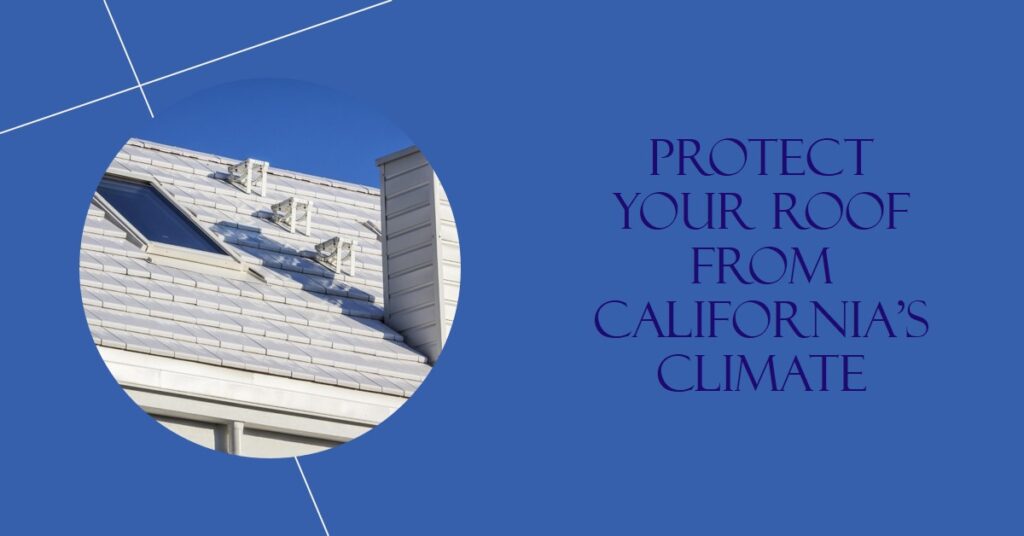The intense heat and frequent wildfires characteristic of California’s weather can greatly affect the condition of your roof.

California’s beauty lies in its diversity, but this diversity is a challenge for roofs. Adapting to this requires a blend of informed material selection, periodic maintenance, and an understanding of regional challenges.
Embracing these measures ensures that the homes under these roofs remain safe, secure, and comfortable for years to come.
California, celebrated for its picturesque landscapes, from sun-baked desserts to snow-draped mountains, isn’t just a visual treat. Its multifaceted climate plays a pivotal role in determining the life and durability of roofs.
Given this vast range of conditions, roofs in California face unique challenges in terms of wear, durability, and maintenance requirements.
California’s Unique Climate Spectrum
California boasts a vast climatic spectrum, from Napa Valley’s vineyards to Malibu’s beaches. This isn’t just a fun fact for geography enthusiasts; it’s crucial knowledge for homeowners.
Roofs are built not just to shelter but to resist the regional conditions they’re in.
Let’s dive deeper into understanding the challenges and requirements of roofing in such a diversified climate.
The Impacts of Sun and Heat
The sun’s powerful rays and intense heat can do more than just warm our planet. Let’s explore how they can affect various things around us, especially when they’re at their strongest.
Ultraviolet (UV) Ray Damage
While a draw for tourists, the Californian sun can be harsh on homes. Continuous exposure to UV rays causes roofing materials to break down faster, making them brittle, prone to cracks, and causing their color to fade.
In regions with almost perpetual sunlight, investing in UV-resistant roofing isn’t just recommended; it’s nearly essential to ensure the roof’s longevity and appearance.
Thermal Expansion and Contraction
But it’s not just the intensity; it’s the fluctuation. California’s characteristic hot days and cooler nights mean roofing materials continuously expand and contract.
Over time, this constant movement can weaken roofs, increasing their vulnerability and decreasing their lifespan. This necessitates the selection of materials built for such dynamic conditions.
Rain and California’s Wet Season
Rain is a welcome sight in California, especially after long dry spells. Let’s dive into how the state’s wet season can influence its landscapes and daily life.
Wear and Erosion from Rainfall
California may be renowned for its sunny disposition, but certain regions, especially Northern California, get their fair share of rain.
Continuous rainfall can lead to erosion, especially if drainage systems aren’t efficient.
This highlights the importance of a robust roofing system that can effectively manage heavy downpours and divert water.
Growth of Mold and Mildew
Dampness and shade are a recipe for mold and mildew. If a roof retains moisture, especially in shaded areas or during prolonged rainy seasons, it’s inviting fungal growth.
This can weaken the roof over time, not to mention the health hazards mold presents. To avoid this, effective ventilation and materials that repel moisture are key.
Snow and Cold in Mountainous Regions
Snow blankets and chilly temperatures transform mountain areas into winter wonderlands. Let’s discover how the cold and snow impact life and nature in these high-altitude places.
Weight and Pressure on Roofs
While beachgoers might be soaking up the sun, regions like the Sierra Nevadas are blanketed in snow. This snow, while picturesque, adds significant weight and strain to roofs.
Like sloped roofs, a roof designed to shed snow and reduce accumulation is a smart choice for homes on these chilly terrains.
Ice Dams and Water Seepage
Melting snow can refreeze at the roof’s edge, leading to ice dams. These dams prevent melting snow from draining, increasing the risk of leaks.
Combating this requires more than just good roofing; homes need proper insulation and ventilation to reduce the risk.
Coastal Concerns: Salt and Moisture
The coast brings the beauty of the ocean, but also challenges like salt and dampness. Let’s delve into how these coastal elements can affect the environment and those living nearby.
Corrosion and Salt Damage
Homes by the sea face another challenge—salt. The salty sea breeze, while refreshing, can lead to faster corrosion of roofing materials, especially metals.
For homes in these areas, corrosion-resistant materials or coatings are essential, ensuring longevity against the persistent oceanic elements.
Persistent Humidity and Condensation
The coastal ambiance comes with increased humidity. This can lead to condensation, which, over time, can damage roofing materials and decrease their efficiency. Integrating proper ventilation systems and moisture barriers can counter these challenges.
Preparing Your Roof for California’s Climate
Choosing the Right Materials
The key to a lasting roof in California lies in material selection. Materials should be chosen not just based on aesthetics but on their resilience to the specific challenges of a region—be it the relentless sun, heavy rainfall, or salty sea breezes.
Regular Maintenance and Inspection
An ounce of prevention is worth a pound of cure. Consistent inspections, especially post-seasonal changes, can identify potential issues before they escalate.
This proactive approach can significantly enhance a roof’s lifespan, ensuring it remains a protective shield against California’s diverse climate.
Adapting to California’s Climate Diversity
The allure of California stems from its varied landscapes and climates, presenting unique challenges for roofing.
To navigate these challenges, combining the knowledgeable choice of materials, regular upkeep, and insights into local climatic demands is essential.
By prioritizing these factors, homeowners can ensure their residences’ longevity, safety, and comfort beneath these roofs.
